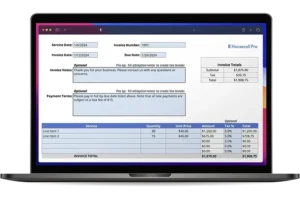Want to win more jobs with less effort?
Grow your business and send quick quotes with our home service software.

Want to see your potential revenue?
See what businesses like yours earn with Housecall Pro in 1 - 2 minutes.

Calculating the perfect heating, ventilation, and air conditioning (HVAC) system size can be tricky, but it’s important to do it right. It’s all about achieving the right balance of comfort and energy efficiency. If the system is too big or too small, you’ll run into issues.
So, to achieve such a balance, you’ll need to enlist your (or your calculator’s) handy dandy math skills. The key to achieving that sought-after balance lies in an accurate HVAC load calculation. Whether you’re a homeowner looking to upgrade your system or an industry professional ensuring optimal performance, understanding HVAC load calculations is essential. Here’s what you need to know.
What is HVAC Load Calculation?
HVAC load calculation is a method that determines what size of HVAC equipment a home needs. It’s incredibly accurate because, unlike some methods, it accounts for various factors unique to the building, including insulation levels, window types, and the number of occupants.
The goal of this calculation? To find the most accurate size of HVAC equipment to heat and cool the building. It shoots for the target size, working to find the tonnage that is neither oversized or undersized, since both can lead to inefficiencies and increased energy costs.
So, to uncomplicate things, this calculation finds the system size that can be installed in a building to adequately maintain a comfortable indoor temperature year-round.
Why is HVAC Load Calculation Important?
HVAC load calculation is important for a handful of reasons. First and foremost, it ensures that HVAC systems can provide efficient and effective cooling or heating, regardless of the season. An oversized unit can be just as problematic as an undersized unit—both can struggle with maintaining consistent temperature, shortened lifespans, and an increased risk of breakdowns.
An undersized unit will struggle to keep the building at a consistent temperature, overworking itself as it attempts to manage indoor temps. On the flip side, an oversized unit might cycle on and off too frequently, opening the door to headaches with uneven temperatures and higher energy consumption. Neither one is ideal. That’s why the HVAC load calculation is so important.
With an accurate HVAC load calculation, you can skirt those all-too-common headaches and ensure the system fits the building’s needs, not just its square footage. In the long run, that translates to improved comfort, enhanced energy efficiency, and lower overall costs. For the customer, the extra time you take to do an HVAC load calculation can make all the difference.
What is the Rule of Thumb for HVAC Load Calculation?
Rule of thumb numbers for HVAC load calculation can vary a bit in the industry, but in general, it hovers around 500 to 600 square feet per ton. It’s best to do a detailed HVAC load calculation, as there’s more to accurate sizing than square footage, but it can be a helpful tool to get a general idea of sizing.
Based on this rule, you would need one ton of heating or cooling capacity for every 500 to 600 square feet of floor space. So, suppose you’re working on a 2,000-square-foot home. In that case, you would need a 3.5 to 4-ton HVAC unit to meet the heating and cooling needs.
Unfortunately, this calculation can give skewed results. It doesn’t account for any of the features unique to the home, such as the quality of the insulation, type of windows, local climate, or the number of people in the home. So, more often than not, sizing based solely on the rule of thumb leads to oversized units.
Considering how problematic an oversized unit can be, it’s best to use this calculation for nothing more than getting a general idea of size. Beyond that, sizing with more accurate HVAC load calculations is ideal. This way, you can choose a system that truly matches all features of the home, not just the floor space. Plus, you can make sure that your HVAC job bids are as accurate as possible and avoid headaches with your service contract or invoice.
How Do You Perform HVAC Load Calculation?
To accurately perform an HVAC load calculation, you’ll need to gather each piece of information. The basic HVAC load calculation formula doesn’t demand ultra-precise information, so if you simply need a guideline, it’s a helpful tool.
For this formula, you’ll need to accurately measure the square footage, ceiling height, and the number of windows, doors, and occupants. Once you have that information, you can plug the numbers into the formula and get your sizing baseline.
If you’re using a more precise calculation method, such as the Manual J method, you’ll need to gather precise measurements and information, including the insulation levels, window areas, and internal and external heat transfer rates. Since a reliable measurement requires accurate information, you’ll need specialized equipment and tools, such as duct testers, thermometers, wattmeters, and blower doors.
Once you have the necessary information, you can plug everything into your formula to get an incredibly accurate load calculation.
HVAC Load Calculation Formula
The formula for calculating HVAC load capacity is:
BTU/h = (square footage * ceiling height) + (windows * windows factor) + (exterior doors * exterior door factor) + (occupants * 100)
The formula accounts for major contributing factors, including the ceiling height, windows, exterior doors, and occupants, allowing it to provide more pinpointed sizing guidelines. It sets the stage for a more accurate calculation, giving you a better idea of what size of air conditioner would work for a particular building. It’s a guideline, and the Manual J process is a great tool for more detailed calculations.
Get In Touch: 858-842-5746
Let us earn your trust
On average, Pros increase monthly revenue generated through Housecall Pro by more than 35% after their first year.
See plan options and feature breakdown on our pricing page.
Examples of HVAC Load Calculation
The HVAC load calculation formula makes it easy to determine an HVAC system sizing guideline for a specific space.
Let’s say we have a 2,000-square-foot house with 9-foot ceilings, 15 windows, three exterior doors, and five occupants. Using the HVAC load calculation, we can get a better idea of what size HVAC unit we’ll need for this home.
The equation will look something like this:
BTU/h = (2,000 square feet * 9) + (15 windows * window factor) + (3 exterior doors * door factor) + (5 occupants * 100)
Using this equation, we can figure out the expected sizing for the HVAC system for this home.
BTU/h = 36,500
Since there are 12,000 BTUs in a ton, we can divide our answer to get the system size in tons.
36,500 / 12,000 = 3.04 tons
So, based on this formula, our example home would need a 3-ton HVAC system to adequately heat and cool it year-round.
HVAC Load Calculator
Computing HVAC system sizes using the HVAC load calculation formula is pretty simple, but the numbers can be rather large. So, to make it easier on you and save you the time of making sure you typed all of those zeroes into your calculator, use Housecall Pro’s free HVAC load calculator.
It’s quick and easy to use—simply plug in your numbers, and it’ll churn out a system size guideline. It’s as uncomplicated as that! In mere seconds, you’ll have an accurate HVAC load calculation to use. Of course, it’s important to remember that the formula is a good guideline, and if you need a precise sizing calculation, the Manual J method is a handy method.
Whether you choose to use the HVAC load calculation formula or take advantage of the free calculator, you can get a better idea of what system size will match the building in question’s heating and cooling needs. No more worrying about oversized or undersized systems that are sure to cause problems!







